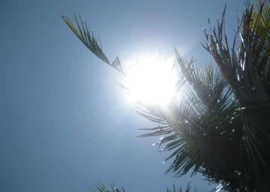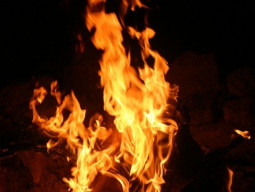
(Read more: Over 2 million affected by floods in Sindh, says NDMA)
"We won't leave until you come with us to save our families," a defiant Ali Mohammad, 27, told the soldier.
"Hundreds of our villagers are trapped in the flood waters but we can't find anyone to help us rescue them."
A year after Pakistan's worst ever floods, the lush southern lands of Sindh are inundated once more, and angry villagers were desperate for help for their families who had escaped several feet of floodwater by sitting on their roofs.
A heated argument ended with a promise that the army would return to help the thousands of marooned residents in Tando Allahyar district, one of the areas worst affected by the deluge.
"We are going to save people in another town -- this delay will risk their lives," the soldier said.
Official figures show the floods have killed nearly 300 people and affected 5.8 million since monsoon rains began last month -- leaving hundreds of thousands living under open skies on hills and along highways.
The number affected is far lower than the 21 million hit by the record floods in 2010, when nearly one billion dollars was given in foreign aid and civilian authorities were accused of a woeful response to the disaster.
Now with Sindh -- worst-hit last year -- again swamped and the response not keeping pace Prime Minister Yousaf Raza Gilani has cancelled a visit to the UN General Assembly in New York to see the aid effort in progress.Islamabad also asked the UN to issue a fresh international appeal for flood donations.
Fewer relief camps have been set up this year and many victims have erected makeshift huts using bamboo, shawls and sheets.
Visits to Tando Allahyar, Badin, Mirpurkhas and Sanghar districts in Sindh showed scores of towns and villages submerged under rainwater that overflowed from drains and canals and swept down from neighbouring mountains.
"Our town is completely submerged. So are dozens of surrounding villages," said Qasim Mallah, 61, a fisherman from Pangrio town in Badin district, 100 kilometres south of Tando Allahyar.
"Most people have left the town, but some have stayed to safeguard their properties from looters," he said.
One rescue worker, Suleman Abro, said the scale of the disaster was once again too much for authorities to handle.
"There are places where military, navy and international organisations are rescuing them, but the effort is too limited as the scale of disaster is much larger," he said.
In the desert district of Thar, residents cut off from transport links by the flooding told AFP by phone that their homes had been inundated, forcing them to climb nearby sand dunes to stay on dry ground.
Supplies were become scarce, said Thar local Harish Kumar. "We are desperately waiting for food supplies, as there are too many hungry and thirsty people," he told AFP.
The UN's food agency said it aimed to provide emergency aid to about half a million people by the end of September, then scale up to reach 2.2 million next month, as it appealed for foreign donations to help assist all those in need.
The World Food Programme said it had begun handing out rations in the worst-hit districts, starting with southern Badin. But many are also facing dire shortages of clean drinking water, leading to outbreaks of acute diarrhoea, according to the World Health Organization (WHO).
"People are drinking filthy water and getting ill. The disaster is worsening every day, every moment," said Aslam Khwaja, a relief worker from People's Development Foundation.
The UN's children agency said it would distribute 200,000 litres of water to 40,000 people daily and deploy 40 more water tankers in coming days, aiming to ensure access to clean drinking water and avert disease.
Deedar Ali, 35, was rescued by a navy boat from a village in Sanghar after, he said, having to sit on the roof of his house with his family for several days.
"Our rations had finished, my goats and buffaloes had died. We saw a few people struggling in the water and thought we would meet the same fate," he said, crumbling into tears.
A boatman in Sanghar's Khipro town that said the navy had only four rescue boats available in the area, and all were being used around the clock.
"We have rescued 5,000 people in four days. There are still many people inside," he said.
COMMENTS (9)
Comments are moderated and generally will be posted if they are on-topic and not abusive.
For more information, please see our Comments FAQ

1725783822-0/Tribune-Pic-(15)1725783822-0-165x106.webp)















Heavy rain hitted our area thousands peoples dispplaced they losts cotton cattels houses govt not helped peples living in upper places they need food fresh water whers r govt ,ngos.edhi.khidmatkhalq icoudn,t see any welfare .our villages r full of water i request the govt of peoples party and other welfares plz help our peoples in deh juman p.o khahi tahsil khipro dist sanghar sindh
@dr.Who ,well sindh and balochistan have a potential to produce 50,000 mg watts of bijli annually ,our consumption is bearly 16,000 mg watts !
@Why: And in addition to building dams, Pakistan should also build castles in the air. In fact building castles in the air is much cheaper and not dangerous at all!
How sad. Poor children and humanity of Pakistan suffering and never got a break. Hope this innocent little girl and her family along with other families gets help soon. God bless this cute little girl and may she keep on smiling. The question is, why does Pakistan not build Dams to prevent this kind of massive flooding? By this time they should have figured something out . . .
millions home less .... its just terrible .... I hope aid reaches them asap.
she is asking for help
cute girl
wow - sweet little innocent - god bless her.